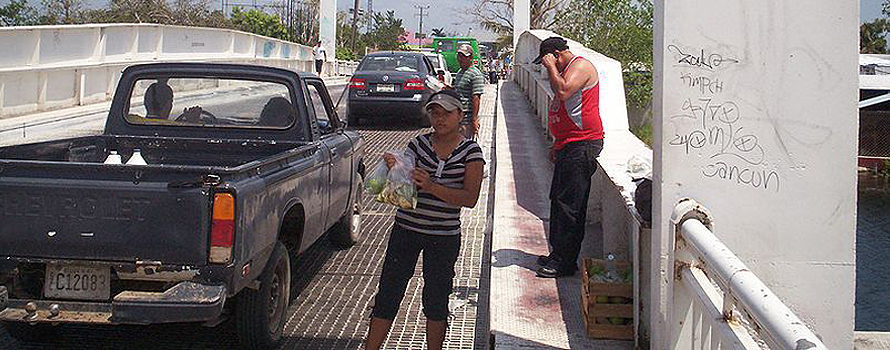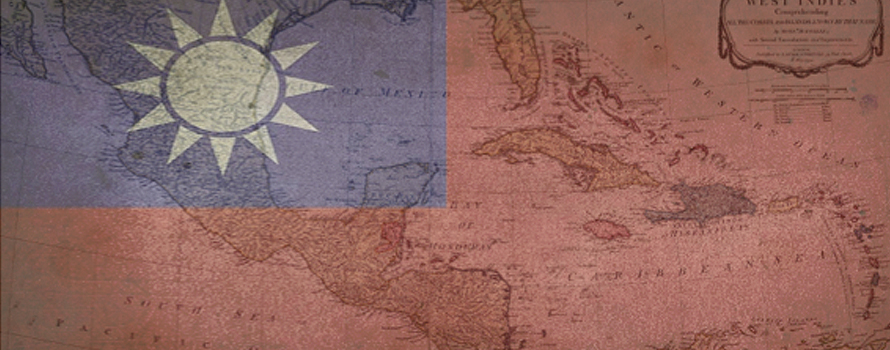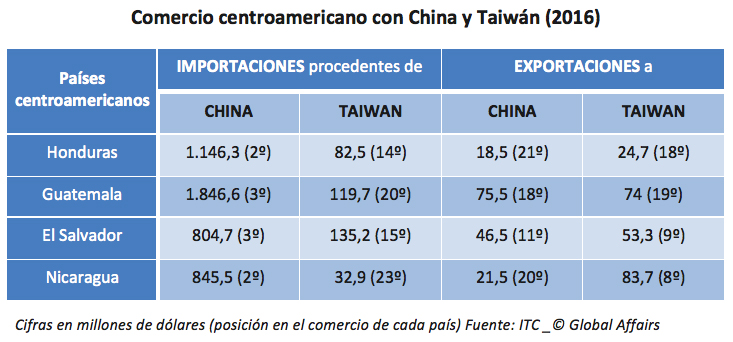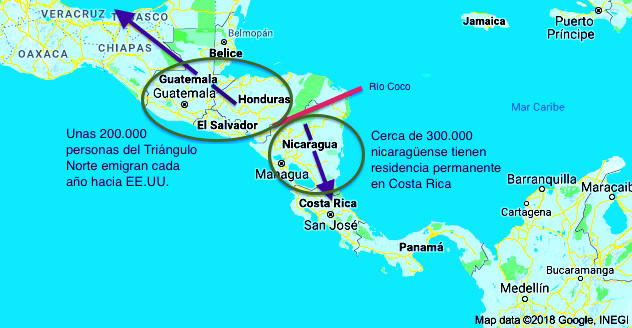Ruta de navegación
Menú de navegación
Blogs
Entries with label Central America .
Central America's Northern Triangle migrants look to the U.S., Nicaragua's to Costa Rica
While migrants from Guatemala, El Salvador and Honduras continue to try to reach the United States, those from Nicaragua have preferred to travel to Costa Rica in recent years. The restrictions put in place by the Trump Administration and the deterioration of the Costa Rican economic boom are reducing the flows, but this migratory divide in Central America remains for the time being.

▲Belize-Mexico border crossing [Marrovi/CC].
article / Celia Olivar Gil
When comparing the Degree of development of the Central American countries, the different human flows operating in the region are well understood. The United States is the great migratory magnet, but Costa Rica is also to some extent a pole of attraction, evidently to a lesser extent Degree. Thus, the five Central American countries with the highest poverty rates -Guatemala, El Salvador, Honduras, Nicaragua and Belize- share their migratory orientation: the first four maintain important flows to the United States, while in recent years Nicaragua has opted more for Costa Rica, given its proximity.
Migration from the Northern Triangle to the U.S.
Nearly 500,000 people try every year to cross Mexico's southern border with the goal to reach the United States. Most of them come from Guatemala, El Salvador and Honduras, the Central American region known as the Northern Triangle, which is currently one of the most violent in the world. The reasons that lead this high issue number of citizens from the Northern Triangle to migrate, many illegally, are various:
On the one hand, there are reasons that could be described as structural: the porousness of the border, the complexity and high costs of regularization processes for migration, the lack of commitment by employers to regularize migrant workers, and the insufficient capacity of governments to establish migration laws.
There are also clear economic reasons: Guatemala, Honduras and El Salvador have high poverty rates, at 67.7%, 74.3% and 41.6%, respectively, of their inhabitants. presentation Difficulties in budgetary income and pronounced social inequality mean that public services, such as Education and healthcare, are deficient for a large part of the population.
Perhaps the most compelling reason is the lack of security. Many of those leaving these three countries cite insecurity and violence as the main reason for their departure. The level of criminal violence in the Northern Triangle reaches levels similar to those of an armed conflict. In El Salvador, a total of 6,650 intentional homicides were registered in 2015; in Honduras, 8,035, and in Guatemala, 4,778.
All these reasons push Guatemalans, Salvadorans and Hondurans to migrate to the United States, who on their journey north use three main routes to cross Mexico: the one that crosses the country diagonally until reaching the area of Tijuana, the one that advances through central Mexico to Ciudad Juarez and the one that seeks to enter the US through the Rio Bravo valley. subject Along these routes, migrants face many risks, such as falling victim to criminal organizations and suffering all kinds of abuses (kidnapping, torture, rape, robbery, extortion...), which can not only cause immediate physical injuries and trauma, but can also leave serious long-term consequences deadline.
Despite all these difficulties, citizens of the Northern Triangle continue to choose the United States as their migration destination. This is mainly due to the attraction of the economic potential of a country like the USA, at status of plenary session of the Executive Council employment ; to its relative geographic proximity (it is possible to arrive by land crossing only one or two countries), and to the human relations created since the 1980s, when the USA began to be goal for those fleeing the civil wars of a politically unstable Central America with economic difficulties, which created a migratory tradition, consolidated by family connections and the protection offered to the newcomers by the already established nationals. During this period, the Central American population in the U.S. tripled. Today, 82.9% of Central American immigrants in the U.S. live in the United States.
|
The American immigration 'watershed' [with ABC's authorization]. |
Migration from Nicaragua to Costa Rica
If emigration from northern Central America has been directed towards the United States, emigration from southern Central America has had more destinations. If Hondurans have looked to the north, in recent years their Nicaraguan neighbors have looked somewhat more to the south. The Coco River, which divides Honduras and Nicaragua, has become a sort of migratory'watershed'.
Certainly there are more Nicaraguans officially residing in the U.S. (over 400,000) than in Costa Rica (close to 300,000), but in recent years the issue of new residents has increased more in Costa Rican territory. In the last decade, from agreement with an OAS report (pages 159 and 188), the US has granted permanent residency program permission to a average of 3,500 Nicaraguans each year, while Costa Rica has granted about 5,000 from average, reaching a record 14,779 in 2013. Moreover, the proportional weight of Nicaraguan migration in Costa Rica, a country of 4.9 million inhabitants, is large: in 2016, some 440,000 Nicaraguans entered the neighboring country, and as many exits were recorded, indicating a significant cross-border mobility and suggesting that many workers temporarily return to Nicaragua to circumvent the requirements de extranjería.
Costa Rica is seen in certain aspects in Latin America as Switzerland in Europe, that is, as an institutionally solid, politically stable and economically favorable country. This means that the emigration of Costa Ricans is not extreme and that people come from other places, so that Costa Rica is the country with the highest net migration in Latin America, with 9% of the Costa Rican population of foreign origin.
Since its independence in the 1820s, Costa Rica has remained one of the Central American countries with the least amount of serious conflicts. For this reason, during the 1970s and 1980s it was a refuge for many Nicaraguans fleeing the Somoza dictatorship and the Sandinista revolution. Now, however, they do not emigrate for security reasons, since Nicaragua is one of the least violent countries in Latin America, even below Costa Rica's figures. This migratory flow is due to economic reasons: Costa Rica's higher development is reflected in the poverty rate, which is 18.6%, compared to Nicaragua's 58.3%; in fact, Nicaragua is the poorest country in the Americas after Haiti.
Likewise, Nicaraguans have a special preference for choosing Costa Rica as a destination because of its geographic proximity, which allows them to move frequently between the two countries and to maintain to a certain extent family coexistence; the use of the same language, and other cultural similarities.
Taiwan imports up to four times more than China from Central American countries that recognize it as a state.
Of the almost two hundred countries in the world, only 19 have diplomatic relations with Taiwan (and therefore do not have diplomatic relations with China). Of these, five are in Central America and four in the Caribbean. The recognition of Taipei has some advantages for these countries, although they have been neutralized by China's commercial weight. Panama established relations with Beijing in 2017 and the Dominican Republic has just done so now. Here we examine the interest that preference for Taiwan still holds for certain Central American countries.

article / Blanca Abadía Moreno
Taiwan's special relationship with Central America dates back to the period following Taiwan's 1971 departure from the United Nations, where Nationalist China was displaced by the People's Republic of China. Several Latin American countries had established relations with Taiwan in the 1960s, but most of them gradually came to recognize Beijing after the UN change. Taiwan retained, however, the support of the Central American nations and in the 1980s also gained the support of small Caribbean islands that then became independent.
The emergence of China as a major international trade partner has been subtracting diplomatic recognition from Taiwan. Costa Rica established full ties with China in 2007, Panama in 2017 and the Dominican Republic last May 1. Even so, of the 19 countries that continue to opt for Taipei over Beijing, five are in Central America: Guatemala, Belize, Honduras, El Salvador and Nicaragua (this country with a five-year hiatus, from 1985-1990). Four others are in the Caribbean: Haiti and three tiny nations in the Lesser Antilles. If one takes into account that the rest of the countries that recognize Taiwan are of little commercial importance, except for Paraguay (they are the Vatican, Burkina Faso, Swaziland and six Polynesian microstates), it is understandable that Central America absorbs Taiwan' s diplomatic interest.
Since the constitutive theory of statehood defines a state as a person in international law if, and only if, it is recognized as sovereign by others, Taiwan strives to ensure that those countries continue to recognize it as a subject of plenary session of the Executive Council law in the concert of nations; losing their support would directly affect the legitimacy of its claims as a sovereign state.
To this end, Taipei promotes trade relations with them, procures investments and uses what is called "checkbook diplomacy": submission of gifts (and bribes) to maintain these relations. Central American countries receive an average of $50 million annually in declared non-reimbursable cooperation. Taiwan directs financial aid to its Latin American partners through the development and International Cooperation Fund(ICDF), with programs ranging from infrastructure construction to coffee production. Taiwan has financed and constructed several government buildings in Nicaragua and El Salvador.
In addition, the Asian nation contributes to programs of the Central American Bank for Economic Integration (CABEI) and is an observer country in the Central American Parliament and other regional organizations.
This effort, however, has not prevented that in recent years there have been casualties among Central American countries that saw him giving diplomatic recognition. Costa Rica's economic development led the country in 2007 to want to improve its trade figures through a rapprochement with China, which involved the opening of an embassy in Beijing and the closure of the one it had in Taipei. For the same reason, Panama also opted in 2017 to break off diplomatic relations with Taiwan, stating that China, a prominent Username of the Panamanian canal, "has always played a relevant role in Panama's Economics " and any restrictions preventing it from remaining so had to be removed.
 |
Commercial relations
Trade relations between Taiwan and the Central American countries that recognize it as a State increased significantly thanks to the opening of the Central American Trade Office(CATO) in Taiwan in 1997, the incorporation of this country into CABEI and the entrance entry into force of several trade agreements. Taiwan signed free trade agreements with Guatemala (2006), with Honduras and El Salvador (2006) and with Nicaragua (2008).
These treaties have especially facilitated Central American exports to Taiwan. As is the case with most Latin American countries, Guatemala, El Salvador, Honduras and Nicaragua have China as one of the main origins of their imports (the first is still the United States). Their political alignment with Taiwan does not prevent them from being customers of Chinese production. Thus, in 2016, China ranked between 2nd and 3rd as a source market, while Taiwan ranked far down the table (between 14th and 23rd). However, the special relationship with Taipei means that Taiwan equals or surpasses China as a destination for the exports of the four Central American countries mentioned. This is the commercial benefit they obtain from the diplomatic recognition of the Asian island.
Of this group of countries, Nicaragua exported the most to Taiwan in 2016 (US$83.7 million) compared to exports to China (US$21.5 million), a ratio of four to one. The main Nicaraguan products exported were shrimp, sugar, beef and coffee.
Honduras exported US$24.7 million to Taiwan -mainly textiles, coffee and aluminum- compared to US$18.5 million to China. El Salvador sent shipments to Taiwan worth US$53.3 million - mainly sugar - and US$46.5 million to China. Guatemala, whose Economics has a larger volume, was the only country to sell more to China (75.5 million), but in figures very similar to those of Taiwan (74 million), to which it sent mainly coffee, paper and cardboard.
With these diplomatic and commercial relations Taiwan intends to show international society that it is a capable ally and manager for international cooperation. It also wants to show the world that Taiwanese diplomacy exists despite China's attempts to isolate it. The fact that China has a special interest in markets that facilitate access to raw materials makes the Asian giant more attentive to relations with several South American countries, rich in minerals; it is there where Beijing concentrates its Latin American investments.
Central America, with less extractive activity, thus escapes China's priority (the interest in the Panama Canal is a case apart), and is left for the time being to Taiwan's action. However, the increasingly residual nature of support for the island and the very weight of relations with China suggest that the Central American countries will continue to join this particular club, one after the other, from leave.

